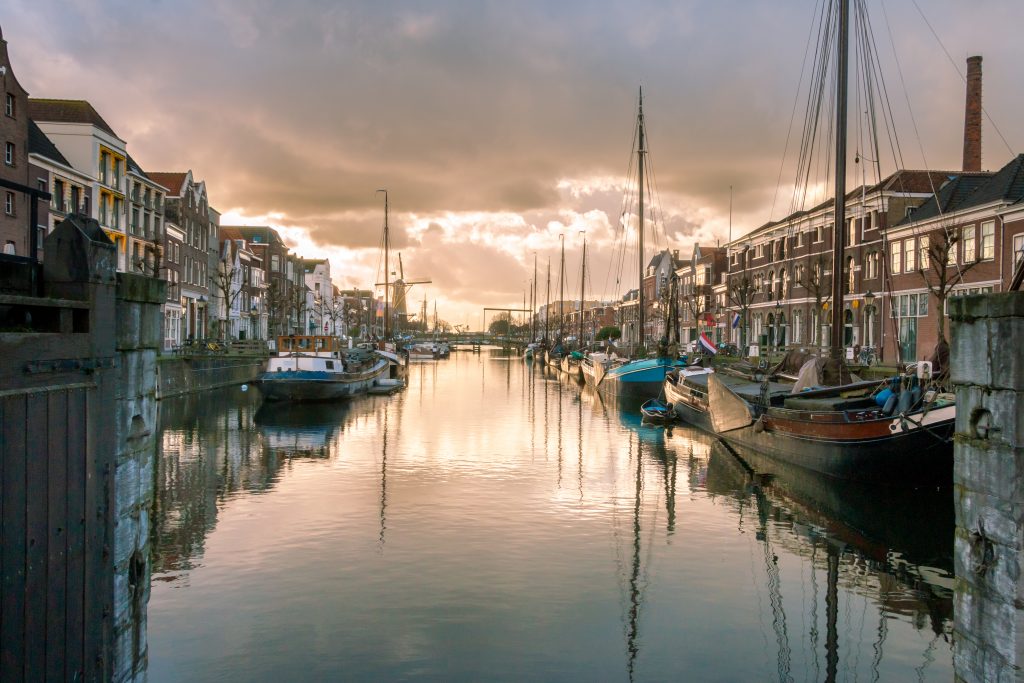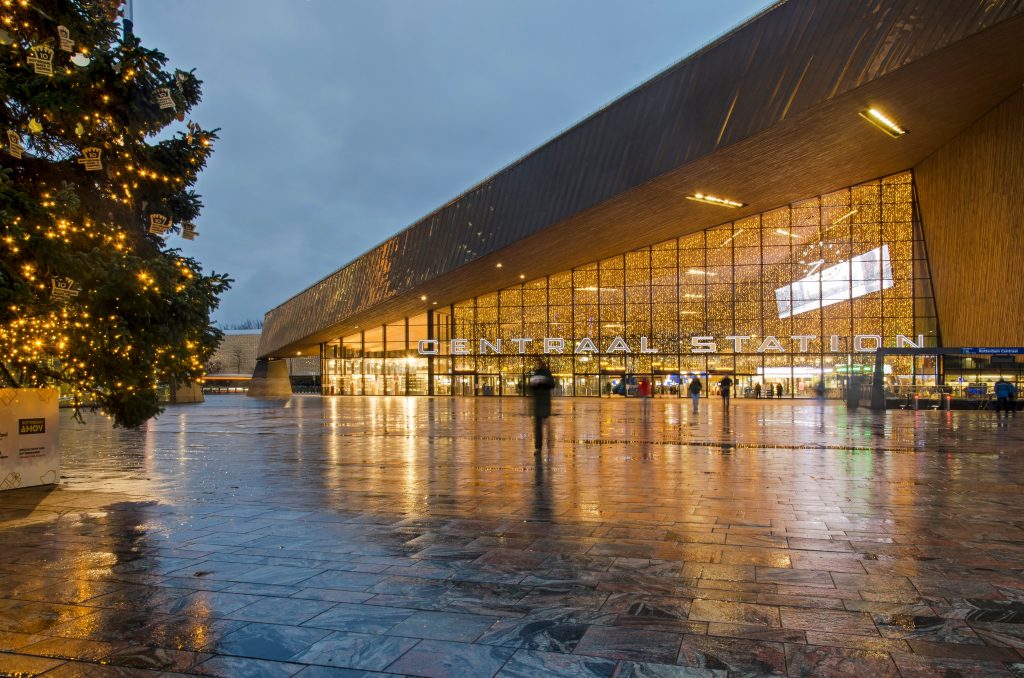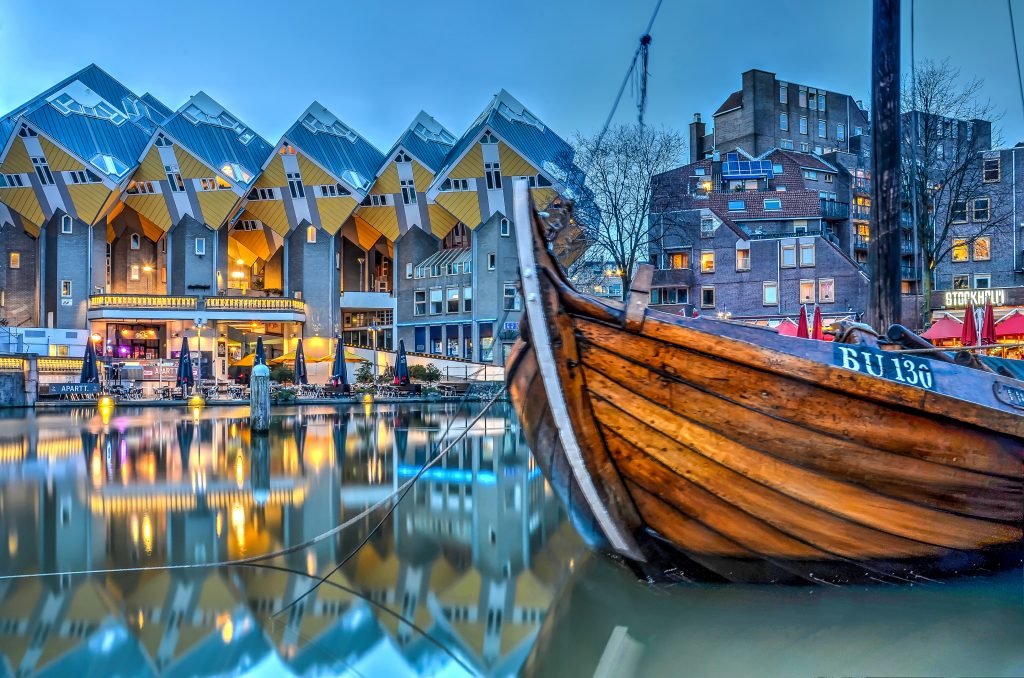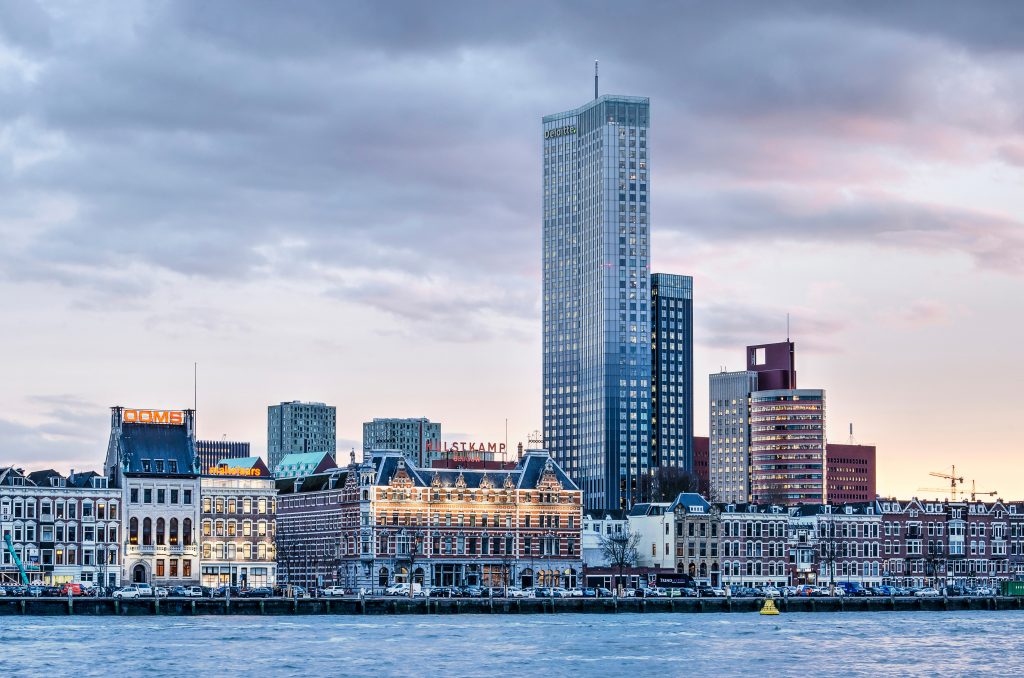Phoebe Skok walks in rain-slicked Rotterdam during the winter, and finds that it is the best way to discover the city’s resilient, pragmatic allure…
By Phoebe Skok
With its harsh yet swooping angles, Rotterdam isn’t as quick a charmer as Amsterdam.
Industrial pragmatism oozes from the city’s unvarnished edges, replacing the flower-lined canals and cobbled brick of the capital with steel and glass. Upon closer inspection, however, it’s clear that Rotterdam, the Netherlands’ second city, is more than just Amsterdam’s misunderstood modernist sister.
Amsterdam leans into its prettiness and idyllic waterways; Rotterdam vigorously embraces its spirit of reinvention. It wasn’t built to be beautiful — it was built to be bold. Under heavy winter skies when the tourists are sparse, the city’s character comes into sharper focus.
Reinvention among the rubble
I arrived in the drizzle: too little rain to justify buying an umbrella, but too many droplets sliding down my glasses to convince myself I wouldn’t be better off with one in hand. As a Seattle native, I felt at home in the watery weather. The city, on the other hand, was anything but familiar as I ventured from the arrow-shaped central train station into the February chill.
Razed to the bones in WWII, Rotterdam rebuilt itself with intention and the quiet confidence that comes from reinventing yourself with the future in mind.
Relics of the war remain, if you know where to look. Brass memorial plaques known as Stolpersteine, or stumbling stones, are scattered throughout paved streets. The historic canal district of Delfshaven is one of the few corners of the city that survived the bombing with its brick buildings intact.
In the end, post-war Rotterdam took advantage of its blank slate and started over. Forward motion permeates through the city’s sharp, sprawling lines, and you get the sense that form and function are locked in a constant battle for control — in Rotterdam, they’re evenly matched.
Cravings and cube houses
Rarely is that interplay more apparent than at the Markthal, an alienesque archway situated near central Rotterdam that houses over 100 eateries and gourmet markets.
Inside, the heady scents of tomato-rich chana masala and slightly smoky döner kebabs mingle with the sizzle of cast iron pans cooking poffertjes, spherical Dutch pancakes dusted with powdered sugar, and the erratic squeaks of rain boots skimming the grey rubber floor. A sweeping mural that’s part fruit bowl, part fever dream stretches across the ceiling.
I wandered in mostly for a break from the rain, but an irresistible desire to taste everything and the comforting smell of something being freshly fried brought me back twice more over the coming days.
Nearby, Rotterdam’s gravity-defying Cube Houses also strike the balance between Brutalist presentation and sleek practicality as they hang from an unassuming façade like a child’s canary-yellow building blocks captured mid-collapse. The Depot Boijmans Van Beuningen, a mirrored bowl that serves as an art storage facility for over 150,000 works, sits across downtown.
From the Maas to the metro
What stitches the city and its million residents together is the Maas river and the wishbone-shaped Erasmus bridge swandiving over the silvery waters. Even when the winter air scratched past my scarf, the Maas rolled on despite the rain.
And rain it does. Often.
Throughout my visit, puddle-dodging was a constant affair, as was munching on thick-cut fries from collapsing paper cylinders and riding the metro lines all the way to the end just to see where I’d land. It was one of those curiosity-fueled impulses that brought me to Hoek Van Holland, where the Maas meanders into the frigid North Sea.
Nicknamed “Rotterdam by the Sea,” the city’s coastal corner is a popular beachfront getaway during the summer months, though you wouldn’t know it in February.
The shore was deserted.
I was alone, save the seabirds and a few bundled-up couples — all of whom were better prepared for the weather than I was. Across the harbor, even the wind turbines were struggling with their cardio; for me, battling the gusts to cross the beach was a full-body endeavor.
Still, I could see the appeal. The coastline was striking in its starkness.
There, in Europe’s largest port, desolate brush-covered dunes bleed into squat container ships crawling across the horizon, and no one thinks anything of it.
I slipped back into the city proper that afternoon, hair mussed but smile bright. A smooth espresso martini and crispy vegan pizza — complete with gooey, housemade “cheese” and a spicy rosemary garlic drizzling oil — left me giddy, full-bellied, and considerably warmer.
A tad absurd
A short train ride the next morning unspooled in Leiden, an artsy college town 20 minutes from Rotterdam with no shortage of glistening waterways, cat-filled neighborhood windows, or bicycles careening every which way.
Within moments of hopping off the train, I stumbled upon Homunculus Loxodontus, a slouched, elephant seal-like creature tucked into the corner of the Leiden University Medical Center.
Created by Dutch artist Margriet van Breevoort to personify the sensation of waiting in a doctor’s office, Homunculus looks how I felt that day: pensively reflective, a tad absurd, and slightly damp from the drizzle.
Still, he was a great start to my day in Leiden, where satisfying my stroopwafel craving was an easy task at the extensive Saturday market. Shinnying up the rickety ladders to the top of the Molenmuseum De Valk, an unexpected gem that preserves the town’s last windmill in its 1900s state, was more daunting but worth it in the end.
Belly full, I followed Leiden’s poetry trail around the city, tracing the lines of verse painted on buildings in dozens of languages.
Rotterdam pulses with a modern, frenetic energy. Leiden invites a slower pace that pulls you toward the small, strange wonders tucked into corners.
Leaving, lightly weathered
Bitterballen, the crispy, molten-stew-centered bar snack of choice for many Dutch, lay at the heart of my last night in Rotterdam. I ducked out into the rain around midnight for one last batch; I’m almost certain bitterballen were specially engineered to combat the city’s evening chill.
Salty? Check. Savory? Check. Strewn lazily across a grease-spattered paper tray and slathered in tangy mustard? Check, and check. Licking my fingers, I stepped back out into the storm.
It rained the day I arrived in Rotterdam. It rained the day I left.
In between, I found a city entirely unbothered by a little weather. The cold softens the edges as the drizzle clears the streets. What’s left?
A bold sketchbook of a city with nothing to prove and everything to share, if you’re willing to brave the rain.
Unless otherwise stated, all photos credit and courtesy of Frank Blok




